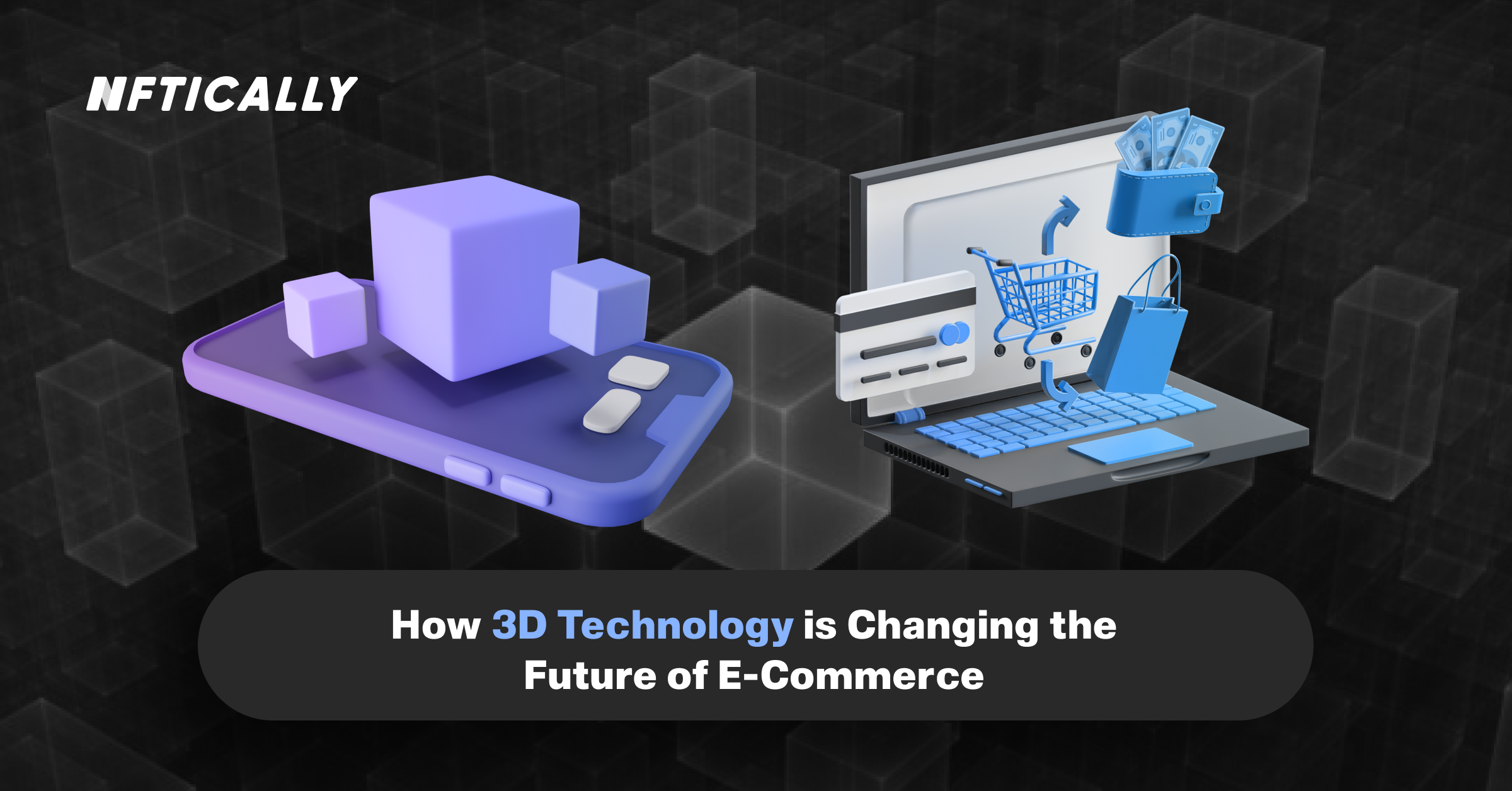- Uncategorized
- March 18, 2023
How 3D Technology is Changing the Future of E-Commerce

3D e-commerce is jeans from every perspective. It is the ability to mix and match shoes, dresses, coats, or belts; to explore the nooks and crannies of an entire home; and to capture the most realistic, detailed view possible.
As enterprises compete for a share of the US$5.2 billion e-commerce industry, presented goods and how effectively buyers engage with them are fundamental problems. However, investing in innovative technologies like zoom features, colorful fabric samples, customized 3D rendering, and 360-degree video could increase e-tailers’ profit lines.
However, let’s discuss e-commerce’s visualization and 3D developments in further depth below:
Measurable ROI
Two years ago, Lands’ End, a direct mail store, made history by adding virtual 3D model functionality to its website. To construct a virtual model that could “try on” digital Lands’ End apparel, users had to answer questions about their height, weight, and face features. Thus, changing the model’s appearance by altering the color of her clothing, accessorizing, or seeing her from other perspectives were all possibilities.
In addition, after a consumer has decided to purchase an item, the virtual model could also use to establish the item’s size.
It claimed that Lands’ End and Canadian partner My Virtual Model saw a 26% rise in new sales and a 13% increase in the average consumer ticket price as of September, almost a year after the feature appeared.
US$2,000 per piece of clothing was the original cost of digitizing Lands’ End’s whole garment inventory at the time of adoption. As a result, researchers say this strategy is now accessible to shops with lesser budgets, as the cost has decreased substantially to between $90 and $200.
Even the Home Shopping Network has agreed to use virtual model technology and Lane Bryant and Glamour magazine.
Betting on the future
My Virtual Model has registered more than 5 million “models,” enabling users to use the same login and password on any partner website. “Try-on” sessions often include roughly 20 clothes, according to Guay.
My VM Email, Guay’s newest offering, lets users build a virtual model and try on clothing without visiting a website.
Future customizable models will be able to function as personal trainers or style counsellors on PCs and mobile devices.
Expected that “all of this will constitute your virtual identity” in the next two years. In weight-loss commercials, personal ads, and virtual cosmetology Virtual models are used.
Zoom Applications
Stores want to introduce less expensive features yet offer buyers a better impression of a product’s characteristics in the near run. However, according to our study, we believe that retailers’ technological costs are slowing the progress of virtual modeling.
Merchants are simplifying product description websites to save download times and help consumers discover what they need. However, some clothing companies emphasize language and images instead of including the latest and most excellent tools. The cost of [these instruments] is relatively high.”
In addition, zoom technology, which firms offer like RichFX and Viewpoint, is the only area in which they are likely to invest. According to a recent Forrester report, 84% of significant retail websites have an image zoom capability.
360 Environments
Regarding “exploring areas,” 3D modeling programs have been employed in the retail clothing industry. Developers create apps that improve touch and smell.
In addition, the fundamental modeling technology, there will be advancements in the rendering algorithms and how realistic it appears, and how quickly you can accomplish it.
According to Forrester, 1/8 of electronics sites like Panasonic and Circuit City let users flip merchandise or view cartoons.
360 View
As one of the leading online image hosting firms, iPix hosts more than 2 million images every day for eBay and provides 360-degree virtual video tours for Realtor.com, eCampusTours.com, and a number of high-end cruise lines. Rivals include Vendaria, a startup that delivers streaming media apps.
Stu Roberson, iPix’s senior vice president of international marketing, says the company’s most recent 3D e-commerce application is a 360-degree virtual tour of Hogwarts on the Harry Potter DVD. The software allows users to experience Harry Potter’s school of wizardry.
For advertising and selling cars, real estate, commercial property, destination, travel hospitality, taking virtual tours of museums—anything that is environment-based, absolutely—Roberson told the E-Commerce Times that “the virtual tour is going to become a norm.”
Virtual tours will be used to advertise autos, real estate, commercial property, holiday spots, and museums.
3D visualizations and renderings are -important to the e-commerce future
In conclusion, due to the COVID-19 issue, the worldwide market for Ecommerce and Other Non-Store Retailers will predict to reach US$9.5 Trillion by 2027, increasing at a CAGR of 19.1% during the forecast period 2020-2027. Thus, with this data, it’s no surprise internet firms are changing.
Let’s take a closer look at some of the most recent developments in e-commerce visualization and 3D rendering software:
1. A/R (Augmented reality)
AR enables clients to have a new and exciting shopping experience by allowing them to project accurate 3D visualizations of things into a natural environment. Thus, using this technology, internet customers can see exactly what they’re purchasing, which helps them make a purchasing choice.
As an excellent example, Baume may provide this service. For a better idea of how your watch will appear on your wrist, try it on with your smartphone connected to the wristband. Therefore, you can make more adjustments to the design before proceeding with the purchase.
2. Mass customization
The primary goal of mass customization is to offer personalized items at a near-mass manufacturing rate. However, e-commerce companies that mass produce to keep costs down and personalise things for clients utilise customisation as marketing.
3. 3D Visuals
Sharing photorealistic images, 3D animation, 360-degree models, and more may assist in the pre-sale of e-commerce items. As a result, businesses can see how their things do in the market and enable consumers to pre-order them. Thus, using 3D visualisations and rendering services, firms may demonstrate their products to attract new customers.
4. Virtual try-on app
Customers may use camera-equipped devices like mobile phones to virtually “test” things before making a purchase. Moreover, Uers may aim their smartphone camera to their wrist to view how a bracelet appears in real life. Customers will enjoy shopping online more if they use this tool to select the right style, size, and fit.
5. 3D configurators
By enabling customers to customize a product according to their preferences and requirements, companies may utilize this software to enhance their e-commerce marketing efforts. Therefore, 3D configurators allow you to customize everything from the color and size of the product to the materials it is made of.
6. Bundling
3D models of the brand’s products are combined by 3D artists and sold as a set at a lesser price than if sold separately. Thus, using conventional photography would be a time-consuming and expensive procedure. For a fraction of the expense and time, 3D visualization may achieve the same results.
Wrapping Up
Making product demos more compelling, streamlining product adaptations, and increasing client retention are all made possible by knowing how successful organizations use 3D technology and the newest trends in the e-commerce market.
Therefore, marketers are advertising digital items in significantly different ways, which is understandable given how quickly the e-commerce business has grown in the last year due to the growing popularity of online shopping for consumer goods.
Using 3D visualization and 3D rendering to apply marketing techniques may help you build your e-commerce company and position your brand to a new level of success.
You may create your own white-label NFT firm or NFT Marketplace using NFTICALLY’s global B2B SaaS platform if you are an NFT holder or NFT enthusiast seeking a native NFT marketplace.
Among the many blogs on NFTICALLY, you’ll find a broad range of perspectives on many different subjects. Join our Discord or Telegram channels if you still have questions after reviewing our Frequently Asked Questions page.
Related Posts

Ballon D’Or Football Awards To Laud Winners with NFTs.
Did you know that the NFT (Non-Fungible Token) sports collectibles market is slated to reach a whopping $2.6 billion in 2022. But, what is the reason behind their massive popularity and huge demand? Sports NFTs give loyal…
- September 29, 2022

What is Bored Ape NFT: Simply Explained
Congratulations if you’re confused by the onslaught of Gorillaz-style monkey avatars on the internet. You’ve just met the Bored Ape NFT Yacht Club for the first time, and it may make even less sense than…
- March 23, 2022
Recent Posts
- Revolutionizing AI Clones: Sunny Leone Teams Up with Kamoto.AI for an Unprecedented Debut
- The Evolving Landscape of NFTs: A Glimpse into 2024
- NFT Trends to Shape 2024: A Deep Dive into the Future of Digital Assets
- The Gaming Revolution: NFTs Level Up the Player Experience
- NFTs and Intellectual Property Rights: Navigating Legal and Ethical Challenges
Recent Comments
Archives
- January 2024
- December 2023
- November 2023
- October 2023
- September 2023
- August 2023
- July 2023
- June 2023
- May 2023
- April 2023
- March 2023
- February 2023
- January 2023
- December 2022
- November 2022
- October 2022
- September 2022
- August 2022
- July 2022
- June 2022
- May 2022
- April 2022
- March 2022
- February 2022
- January 2022
- December 2021
- November 2021
- October 2021
- September 2021
- August 2021
- July 2021
Categories
- $ECOM
- 3D NFTs
- AI Characters
- Airdrpos
- Bitcoin
- Blockchain
- Blockchain Technology
- Buy NFTs
- Buying
- Crypto Collectibles
- Crypto Wallet
- Cryptocurrency
- Cryto Mining
- Digital Art
- Digital Assets
- Ethereum
- FAQs
- Features
- Generative Art Nfts
- ICO
- Invest in NFT
- Learn
- Metavatars
- Metaverse
- Minting
- NFT
- NFT 2.0
- NFT Art
- NFT Art Finance
- Nft auction
- NFT Communities
- NFT Crypto
- NFT crypto art
- NFT Drops
- NFT Games
- NFT gaming
- NFT Marketplace
- NFT Memes
- nft project
- NFT Royalties
- NFT Staking
- nft stocks
- NFT Store
- NFT Taxes
- NFT Trading Cards
- NFT Wallet
- NFTICALLY
- NFTs
- Non fungible tokens
- Non Fungile Tokens
- Ordinal NFTs
- Physical Assets
- Press Release
- Selling
- Solution
- Stablecoins
- Store
- Tensor Nfts
- Top Cryptocurrencies
- Uncategorized
- Web 2.0
- Web 3.0
- white label nft marketplace

